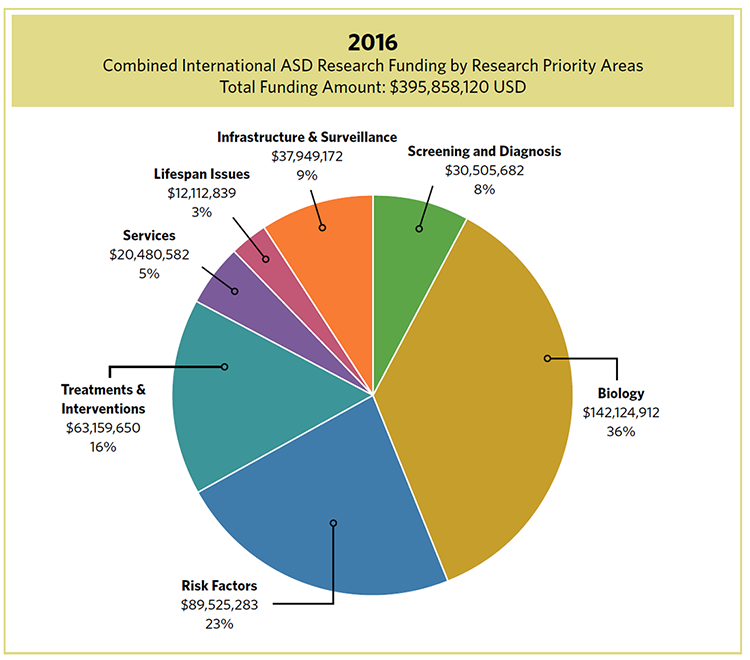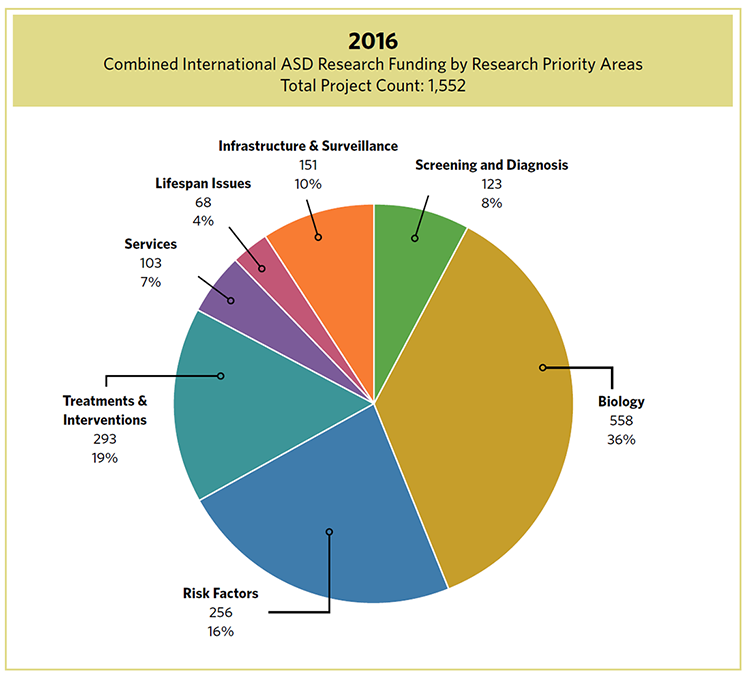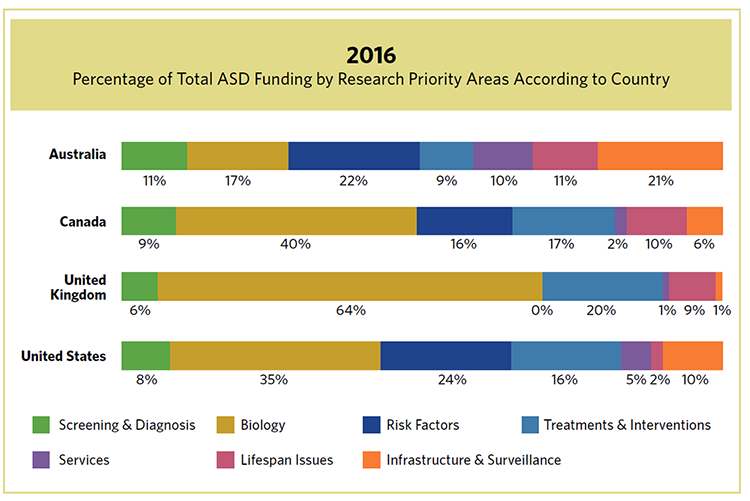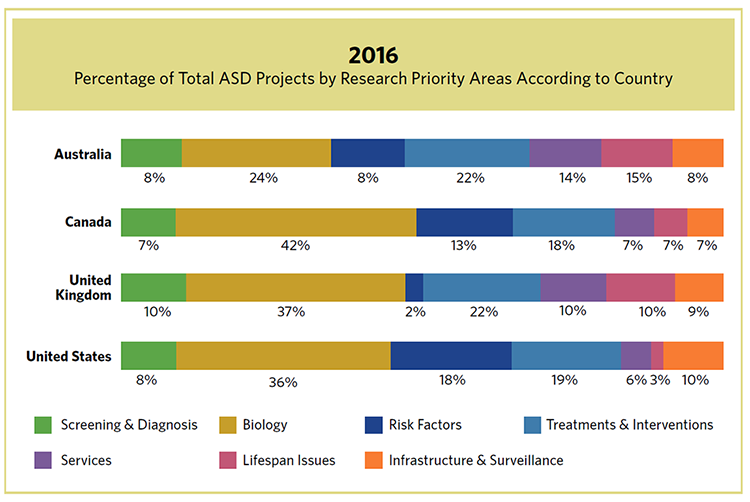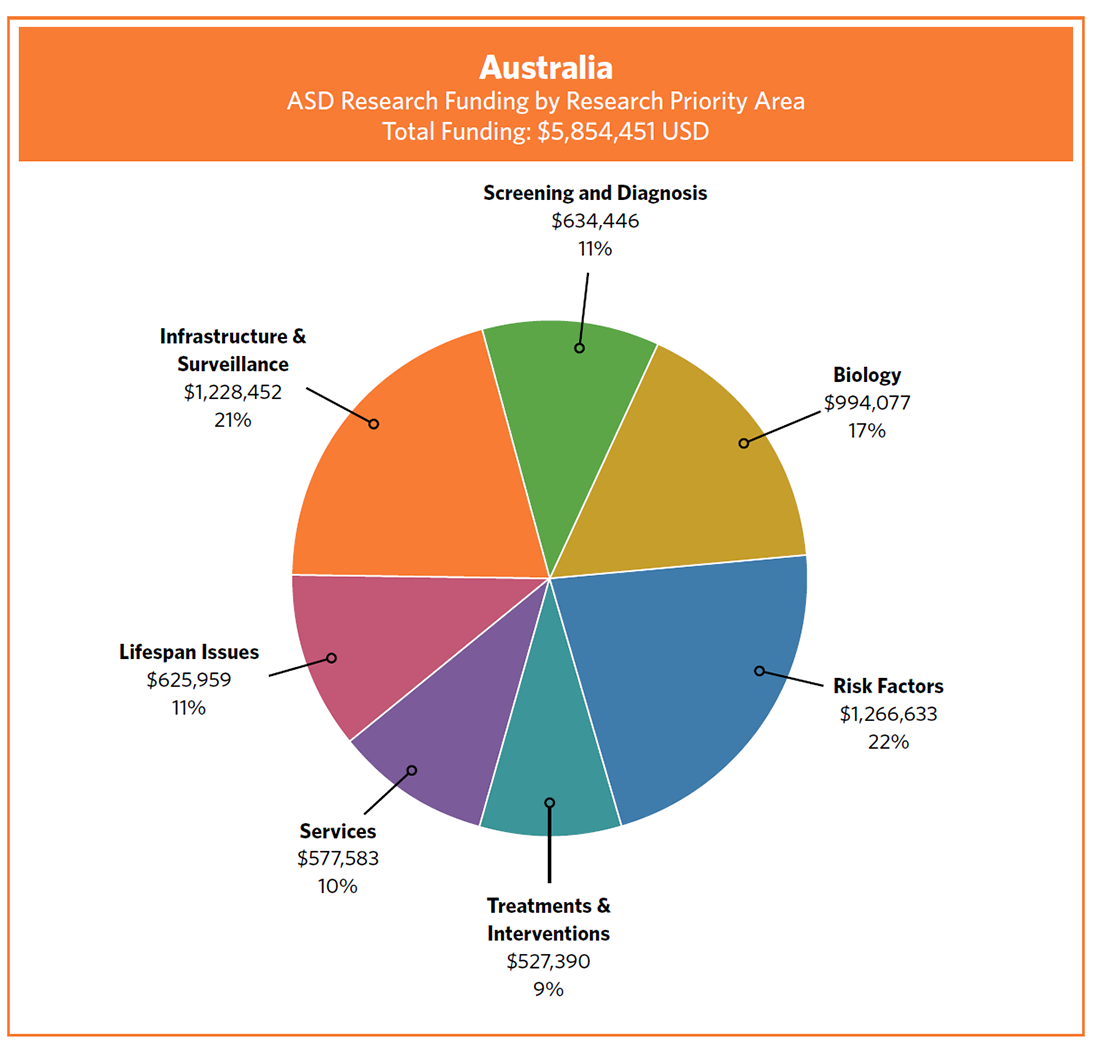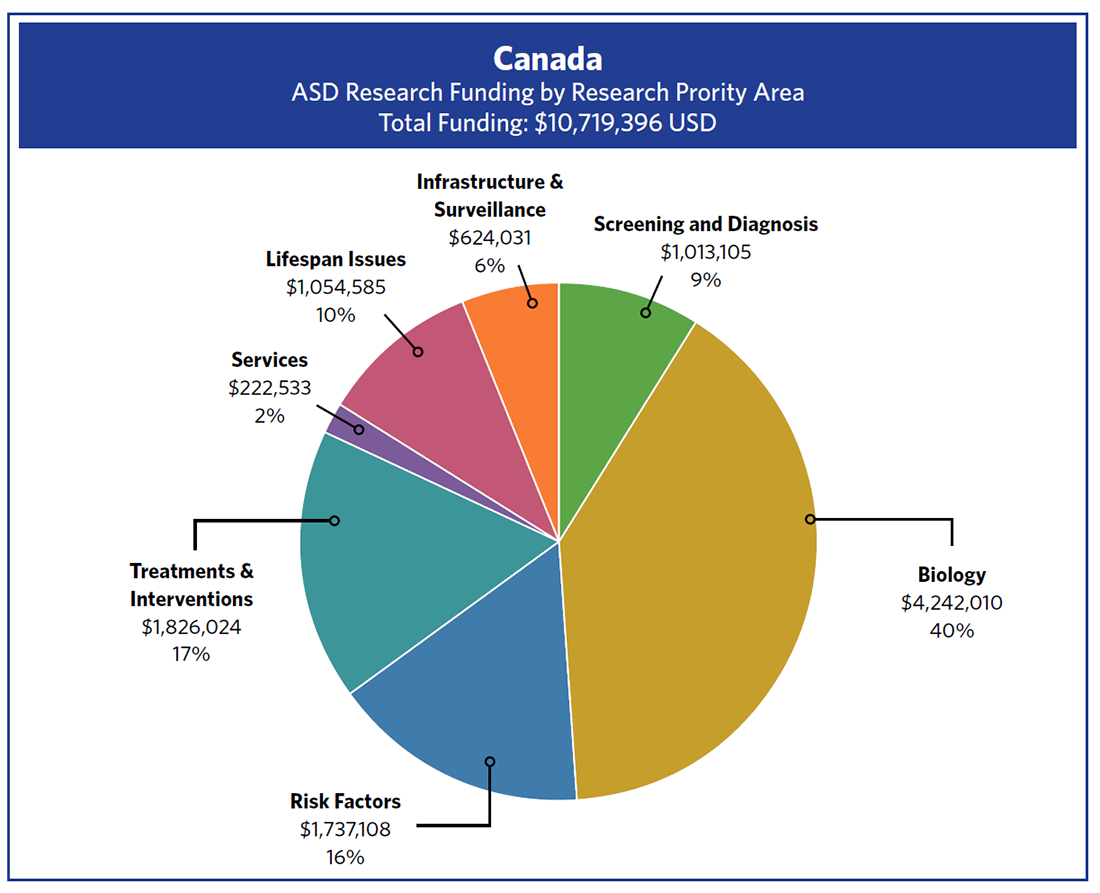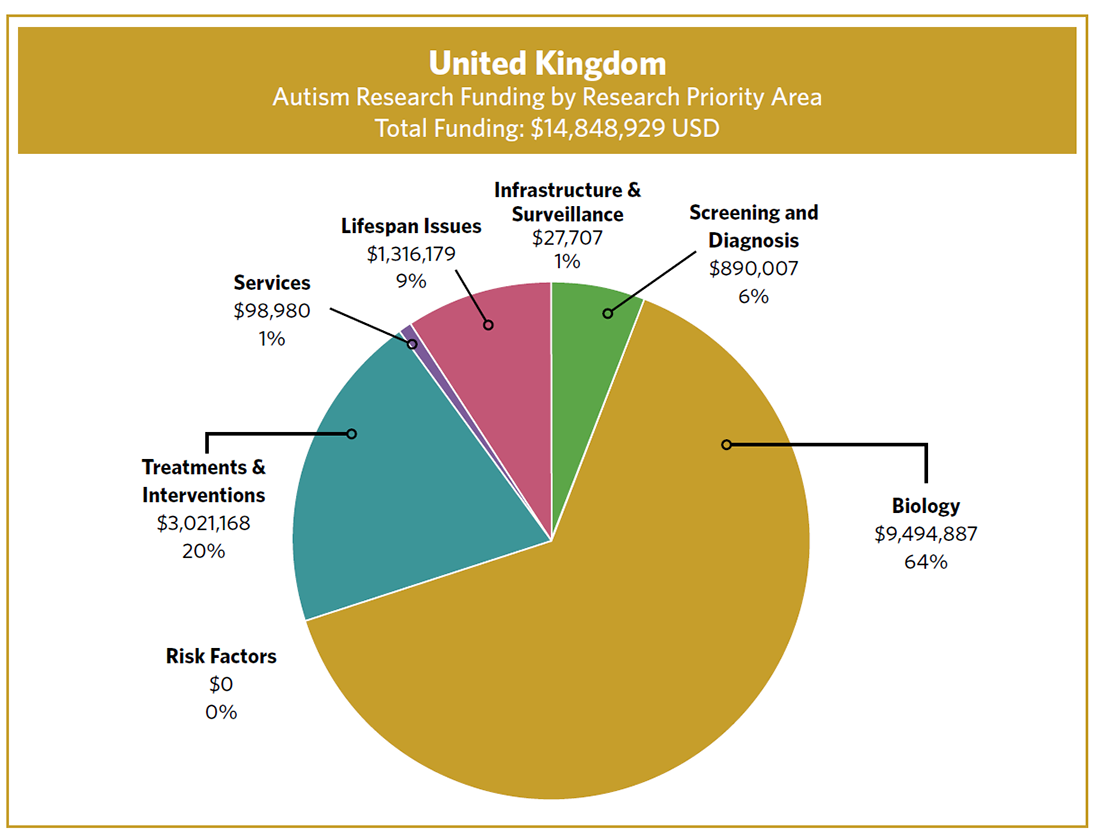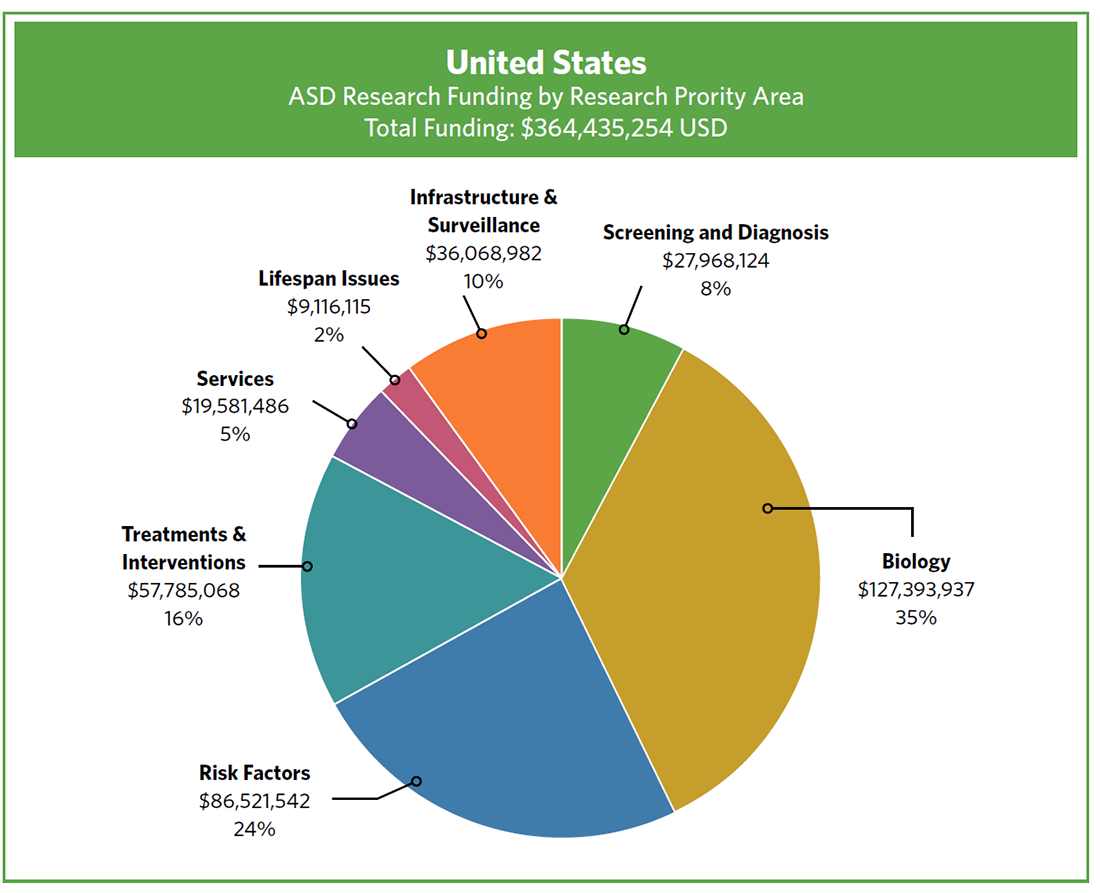International Portfolio Analysis Report
Autism Spectrum Disorder Research
2016
Analysis of ASD Research Priority Areas in 2016
ASD Research Priority Areas Funded in 2016
Using the IACC Strategic Plan framework, projects were aligned with the seven research priority areas to better understand what areas of research were funded in 2016. Figure 2 illustrates the breakdown of the combined research funding from the four countries across the seven research priority areas: Screening and Diagnosis, Biology, Risk Factors, Treatments and Interventions, Services, Lifespan Issues, and Infrastructure and Surveillance. Identifying how current research investments correspond to the research areas provides an understanding of which areas are well-supported versus those that may need additional attention or development.
Figure 2. The combined total investment from the four countries in the seven research priority areas.
International ASD research funding in 2016 supported projects relevant to all seven research priority areas. Described below is the combined investment from all four countries towards each of the seven research areas:
- Biology of ASD: The largest portion of funding addressed the underlying biology of ASD (36%). Projects assigned to this research area seek to understand the biological differences and mechanisms in early development and throughout life that contribute to ASD symptoms, as well as the characterization of the behavioral and cognitive aspects of ASD.
- Risk Factors: This was the second largest funded research area (23%); research in this priority area aims to identify potential causes and risk factors for ASD. Projects associated with risk factors explore the role of genetics, epigenetics, and the environment in the development of ASD, as well as the interactions between risk factors.
- Treatments and Interventions: Research into treatments and interventions for ASD, including behavioral therapies, pharmacological treatments, and technology-based interventions, followed with 16% of total funding in 2016.
- Infrastructure and Surveillance: Investment in infrastructure and surveillance was 9% of overall funding. Projects included in infrastructure and surveillance cover research infrastructure, data sharing, ASD surveillance, and the communication/dissemination of research findings and evidence-based practices. There is also a focus on increasing participation in the collection of biospecimens as well as developing the professional workforce that conducts research and provides services to individuals with autism and their families.
- Screening and Diagnosis: Research to improve screening and diagnosis of ASD was 8% of research funding in 2016. Projects included within screening and diagnosis comprise research to develop and improve biomarkers, screening tools, and diagnostic instruments to aid in early identification.
- Services: This area, which focuses on funding research to improve services and supports for people with ASD, received 5% of ASD research funding.
- Lifespan Issues: This area had the least amount of funding (3%); research in lifespan issues identifies and addresses the needs of youth with ASD transitioning to adulthood as well as quality of life factors throughout the lifespan.
When the number of projects that align with each research area is considered, as opposed to the total funding for these projects, the distribution is slightly different due to differences in the relative sizes of projects falling under each of the seven research categories as well as each country's funding mechanisms. In 2016, there were 1,552 projects total. The percentage of total projects aligned with each research area were as follows: Screening and Diagnosis, 8%; Biology, 36%; Risk Factors, 16%; Treatments and Interventions, 19%; Services, 7%; Lifespan Issues, 4%; Infrastructure and Surveillance, 10% (Figure 3).
Figure 3. The combined 2016 projects provided by Australia, Canada, U.K., and the U.S. aligned to the seven research areas.
Comparative Analysis of Each Country's ASD Research Portfolio by Research Priority Areas
Due to the significant differences in funding and project counts among the four countries, comparing funding towards the seven research priority areas by dollar amounts would provide minimal information on research trends across the four countries. A more useful comparative analysis would be to assess the proportion of each country's portfolio towards the seven research priority areas. Figure 4 displays the differences and similarities in funding priorities among Australia, Canada, United Kingdom, and the United States. Some of the notable trends include:
- Screening and Diagnosis: Each of the four countries has similar proportions in funding in screening and diagnosis, with nearly a tenth of each country's funding going towards this research area.
- Biology of ASD: For the U.K., U.S., and Canada, biology was the greatest area of investment. For Australia, biology received a significant investment, although it was not its most well-funded research area.
- Risk Factors: Research into identifying risk factors was the largest funded area in Australia, the second largest funded area in the U.S. and the third largest funded area in Canada. The U.K. did not fund research for risk factors in 2016.
- Treatments and Interventions: Across all four countries, treatments and interventions saw considerable portions of funding.
- Services: Services research had varying degrees of investment. Australia had the largest proportion of investment in services research among the four countries. For the U.K. and Canada, it was the least funded area of research.
- Lifespan Issues: Research on lifespan issues received a similar proportion of funding in Australia, Canada, and the U.K., whereas it was the least funded area of research in the U.S.
- Infrastructure and Surveillance: There were also differences in infrastructure and surveillance investment among the four countries. It was the second largest funded area in Australia and had a significant portion of funding in the U.S., however it was a small portion of funding for Canada and the U.K. in 2016.
Figure 4. The percentage of ASD funding by research priority areas for Australia, Canada, United Kingdom, and the United States. Due to rounding, the percentages for each country may not add to 100 and research priority areas with less than 1% have been rounded up to 1%.
While the funding information provides an idea of each country's interests in ASD research, it is equally important to look at the proportions of each country's project counts towards the research priority areas (Figure 5). Due to differences in funding mechanisms among the countries and the amount of funding needed for different areas of research, the proportion of ASD projects by research priority area displays a different perspective than the funding percentages for each country. Highlights among the seven research priority areas are listed below:
- Biology of ASD: Across the four countries, biology had the largest proportions of research projects.
- Treatments & Interventions: Research on treatments and interventions had the second largest proportion of projects among the four countries.
- Risk Factors: Research on ASD risk factors was a prominent research area for the U.S. and Canada portfolios, while it was a slightly smaller portion of Australia's portfolio. Risk factors had the smallest percentage of projects for the U.K. However, the U.K. did not have any funding associated with risk factors in 2016, therefore this shows there is ongoing research on risk factors in the U.K.
- Screening and Diagnosis: Research on screening and diagnosis had similar proportions of projects among the four countries, with nearly a tenth of each country's project count.
- Services: When comparing the proportions of projects assigned to services, Australia had the largest percentage designated to services research. The U.S. had the smallest proportion of projects associated with services research among the four countries.
- Lifespan Issues: The percentage of project counts for research in lifespan issues followed similar patterns to the funding proportions; Australia, Canada, and the U.K. had a larger number of projects assigned to lifespan research than the U.S.
- Infrastructure and Surveillance: The four countries had similar proportions of projects in infrastructure and surveillance. Each country had nearly a tenth of projects assigned to infrastructure and surveillance.
For a more in-depth analysis of each country's portfolio, the following sections in this report will provide an overview of progress in 2016 on each country's investments in ASD research as well as details about specific initiatives.
Figure 5. The percentage of total ASD projects for each country by research priority areas. Due to rounding, the percentages for each country may not add to 100.
Australia's 2016 Autism Research Portfolio
Australia invested in autism research projects that aligned with all seven of the research priority areas in 2016 (Figure 7). Differing from the other three countries, the largest proportion of funding went towards investments in Risk Factors (22%), closely followed by Infrastructure and Surveillance (21%). The next largest funded area supported understanding the underlying Biology of ASD (17%). The remaining four priority areas received similar investment: Lifespan Issues and Screening and Diagnosis each received 11% of Australia's total funding, Services received 10%, and Treatments and Interventions received 9%.
Assessing Australia's portfolio, project counts assigned to each research priority area varied compared to the funding patterns (Table 12). Similar to the U.K. portfolio, it is important to review the project counts for each research priority area as Australia funds their projects in the first year of research only. The largest proportion of research projects were assigned to Biology (14 projects). This was followed by 13 projects in Treatments and Interventions, 9 projects in Lifespan Issues, and 8 projects in Services research. The final three research areas each had 5 projects in 2016: Screening and Diagnosis, Risk Factors, and Infrastructure and Surveillance.
Australia's portfolio was more evenly distributed across the seven research priority areas than the other countries included in the analysis. A previous portfolio analysis of 2008 - 2017 funding indicates that this even distribution has been a consistent feature of Australian investment in autism research since 2013.11 Australia's autism research ($5.9 million) is relatively small in comparison to the other countries. As a result, Australia's funding and project count both provide important data. Since research funding is awarded in the first year of the project, it is important to note that the profile of funding in a given year may be affected by any particularly large grants allocated in that year. For example, during the 2016 period, Risk Factors and Infrastructure and Surveillance were the most-funded research priority areas in Australia; however, both priority areas received single grants valued at more than $1 million in 2016. During the same period, these priority areas had the lowest project counts.
Autism research in Australia underwent a transformation in 2013, with the establishment of the Autism CRC, a government-funded Cooperative Research Centre. The Autism CRC is a progressive research organization, with a focus on the empowerment of autistic people and a commitment to inclusive and participatory research practice. Autism CRC deliberately invests in research across the lifespan, with three programs of research: Early Years, School Years, and Adulthood. Across these three programs, Autism CRC has invested in more than 60 research projects across its six years of operation.
Of particular note, within the Early Years program, Autism CRC invested in the creation of the Australian Autism Biobank, a repository of biological and phenotypic data from almost 3,000 participants. Data from the biobank will be used to inform research supporting earlier and more accurate autism diagnosis. In 2016, the Autism CRC invested $1.2 million ($1.7 million AUD) in infrastructure to support the Australian Autism Biobank. Within the School Years and Adult Years programs, Autism CRC invested in three longitudinal studies: a study of children on the spectrum aged 4 - 15, a study of autistic school-leavers aged 15 to 25, and a study of autistic adults aged 25 and over. Together, these longitudinal studies will provide a comprehensive profile of autistic Australians across the lifespan, contributing to understanding of autistic developmental trajectories and outcomes.
The other major organization funding autism research in Australia is the National Health and Medical Research Council (NHMRC). The NHMRC is Australia's leading health and medical research funding body, and consistent with this remit, their investments in autism research primarily fund research targeting Biology and Risk Factors. For example, of the six autism research projects funded by the NHMRC in 2016, five focused on either Biology or Risk Factors, including one large grant of over $1.2 million ($1.7 million AUD) to a project focusing on autism genetic discovery.
Figure 6. Australia's 2016 autism research portfolio represented by the seven research topic areas. Due to rounding, the percentages for each country may not add to 100.
Australia
| Autism Research Priority Area | Project Count (%) |
|---|---|
Autism Research Priority AreaScreening & Diagnosis |
Project Count (%)5 (8%) |
Autism Research Priority AreaBiology |
Project Count (%)14 (24%) |
Autism Research Priority AreaRisk Factors |
Project Count (%)5 (8%) |
Autism Research Priority AreaTreatments & Interventions |
Project Count (%)13 (22%) |
Autism Research Priority AreaServices |
Project Count (%)8 (14%) |
Autism Research Priority AreaLifespan Issues |
Project Count (%)9 (15%) |
Autism Research Priority AreaInfrastructure & Surveillance |
Project Count (%)5 (8%) |
Autism Research Priority AreaTotal |
Project Count (%)59 |
Table 11. Australia's 2016 projects aligned to the research topic areas.
Canada's 2016 Autism Research Portfolio
In 2016, Canada supported research projects towards all seven of the ASD research priority areas (Figure 7). The largest amount of funding went towards understanding the underlying Biology of ASD (40%). Research funding towards developing and improving ASD Treatments and Interventions received 17% of Canada's total funding and it was followed closely by funding towards studying Risk Factors for ASD (16%). The next most highly-funded research areas were Lifespan Issues, which received 10% of funding, and Screening and Diagnosis, which was 9% of Canada's ASD portfolio. The last two areas of research funding were Infrastructure and Surveillance (6%) and Services (2%).
When viewing Canada's projects assigned to each research priority area there is a similar trend to the funding patterns (Table 12). Biology had the largest portion of research projects assigned to a priority area (31 projects). It was followed by 13 projects in Treatments and Interventions and 10 projects towards research to discover Risk Factors. The last four research areas each had 5 projects in 2016: Screening and Diagnosis, Services, Lifespan Issues, Infrastructure and Surveillance.
The Kids Brain Health Network (KBHN), a public-private partnership that includes support from CIHR, is the leading pan-Canadian research network dedicated to understanding the genetic and environmental causes of neurodevelopmental disorders, focusing on ASD, cerebral palsy and fetal alcohol spectrum disorders. The KBHN represents a total federal investment of $39 million CAD, including $9.3 million CAD from CIHR. ASD researchers from the network come from multiple scientific disciplines and collaborate with community, industry, government and non-profit stakeholders to understand the genetic and environmental causes of autism. KBHN's focus on ASD research spans four broad topics and areas of strategic importance: Genomic and epigenetic influences on development and symptoms of ASD, Early Detection Research, Social Communication and Resiliency, Youth Perspectives. Each of these topics have research efforts focused on all seven of the IACC ASD research priority areas.
ASD researchers affiliated with the network recently developed the Social ABCs early behavioral intervention program – a 12-week evidence-based intervention for ASD targeting toddlers (18-30 months) with confirmed or suspected ASD. It teaches parents how to help toddlers vocalize in more meaningful ways. KBHN turned it into a train-the-teacher program for early childhood educators (ECEs), demonstrating that Social ABC's is an accessible, less resource-intensive and less costly option for parents to assist their child in developing communication skills, without having to wait for a formal ASD diagnosis. Researchers from the KBHN continue to improve the effectiveness of the program.
The non-profit organization, the Ontario Brain Institute (OBI), supports the Province of Ontario Neurodevelopmental Disorders (POND) research network, which is investigating the biology underlying neurodevelopmental disorders, including ASD, to create new opportunities for improved care and long-term outcomes for children. Funding included in this analysis reflects children recruited with a primary diagnosis of ASD. The goal of the network is to understand the biological mechanisms underlying these disorders and subgroup individuals based on biology rather than diagnostic label, which may result in more targeted treatments. While POND projects were aligned with the biology research area, it is important to note that the research being conducted within the network encompasses biology, risk factors, and treatment research.
The Brain Canada Foundation (BCF) supported research in 2016 across screening and diagnosis, biology, risk factors, and treatments and interventions. The non-profit organization focuses on understanding the brain and its role in diagnosis and treatment of disorders of the brain. In 2016, the BCF funded several projects investigating the neuronal function in autism as well as examining visual attention in infants to create novel assessments for early detection and treatment.
High impact in ASD research in Canada is also achieved through private and government support of the Canada Research Chairs program in the research areas of Treatments and Interventions, Services, Biology, and Risk Factors:
- Dr. Evdokia Anagnostou, holds a Canada Research Chair in Translational Therapeutics in ASD, focusing on translating basic scientific findings into treatments for patients;
- Dr. Christopher Brett holds a Canada Research Chair in Cellular Science & Human Health, focusing on understanding the biology of autism using mouse models;
- Dr. Daniel Goldowitz, holds a Canada Research Chair in Developmental Neurogenetics, focusing on identifying genes that are critical to healthy brain development and function.
Figure 7. Canada's 2016 ASD portfolio represented by the seven research priority areas.
Canada
| Autism Research Priority Area | Project Count (%) |
|---|---|
Autism Research Priority AreaScreening & Diagnosis |
Project Count (%)5 (7%) |
Autism Research Priority AreaBiology |
Project Count (%)31 (42%) |
Autism Research Priority AreaRisk Factors |
Project Count (%)10 (13%) |
Autism Research Priority AreaTreatments & Interventions |
Project Count (%)13 (18%) |
Autism Research Priority AreaServices |
Project Count (%)5 (7%) |
Autism Research Priority AreaLifespan Issues |
Project Count (%)5 (7%) |
Autism Research Priority AreaInfrastructure & Surveillance |
Project Count (%)5 (7%) |
Autism Research Priority AreaTotal |
Project Count (%)74 |
Table 12. Canada's 2016 projects aligned to the research priority areas.
United Kingdom's 2016 Autism Research Portfolio
The U.K. provided autism research funding for six of the seven research priority areas in 2016 (Figure 8). The largest portion of funding went towards Biology (64%). Investment in biology research in the U.K. was significant in 2016. Although investment in biology is ongoing in the U.K., the annual figure for 2016 was elevated by an uncharacteristically large grant (£2.8 million/$4 million). The grant was awarded by the Wellcome Trust to the University of Edinburgh to improve understanding and treatment of MeCP2-related disorders. The 5-year program of work seeks to better understand MeCP2 binding in vivo; how and why gene expression is affected by varying levels of MeCP2; and will explore therapeutic options for treatment of Rett syndrome and MeCP2 Duplication Syndrome.
As with the three other countries, the U.K. supports significant investment in Treatments and Interventions (20%), which was the second largest funded research area among the U.K. autism research portfolio. A significantly large project included in the portfolio was the Paediatric Autism Communication Trial (PACT-G), which was funded by the National Institute for Health Research, a public body agency. The goal of this project is to bridge the gap between research and practice – the project will test a clinic-assessed treatment in home and school contexts with the hopes of demonstrating the same treatment gains in a clinical setting. In 2015, Autistica initiated a priority setting partnership to work with all those who know about and understand autism to identify the Top 10 priorities for research. The resulting priorities are largely intervention- focused. Thus, the significant investment in Treatments and Interventions represents the research appetite in the U.K. This could also go some way in explaining the lack of Risk Factors (0%) investment in the U.K., as this kind of research has not been a high priority within the U.K. autism community.
The U.K. has a relatively large investment in Lifespan Issues (9%) research. Autism and Ageing was identified as a key priority for autism research in the Autistica Research Strategy. Autistica invested in an ongoing ‘Programme of Research for Autism and Ageing' at Newcastle University. Also, the U.K. funded several projects that fell into Screening & Diagnosis (6%), including a project supported by the Economic and Social Research Council aimed at addressing whether females with autism are being missed by current diagnostic practices. Lastly, the U.K. supported a few projects towards Services research (1%); and one project to support Infrastructure and Surveillance research efforts (1%).
Particularly for the U.K. portfolio, it is important to review the project counts for each research priority area as the U.K. funds their projects in the first year of research only. Assessing the project counts ensures evaluation of the U.K.'s autism research priorities outside of funding. For the U.K., in 2016 there were research projects in each of the seven research areas (Table 13). Mirroring the U.K.'s 2016 funding, Biology had the most projects (22 projects) followed by Treatments and Interventions (13 projects). The research priority areas of Services, Lifespan Issues, and Screening and Diagnosis each had 6 projects, while Infrastructure and Surveillance had 5 research projects and Risk Factors had one continuing project in 2016.
Figure 8. United Kingdom's 2016 autism portfolio represented by the seven research priority areas. Due to rounding, the percentages for each research priority area may not add to 100 and areas with less than 1% have been rounded up to 1%.
United Kingdom
| Autism Research Priority Area | Project Count (%) |
|---|---|
Autism Research Priority AreaScreening & Diagnosis |
Project Count (%)6 (10%) |
Autism Research Priority AreaBiology |
Project Count (%)22 (37%) |
Autism Research Priority AreaRisk Factors |
Project Count (%)1 (2%) |
Autism Research Priority AreaTreatments & Interventions |
Project Count (%)13 (22%) |
Autism Research Priority AreaServices |
Project Count (%)6 (10%) |
Autism Research Priority AreaLifespan Issues |
Project Count (%)6 (10%) |
Autism Research Priority AreaInfrastructure & Surveillance |
Project Count (%)5 (9%) |
Autism Research Priority AreaTotal |
Project Count (%)59 |
Table 13. The United Kingdom's 2016 projects aligned to the research priority areas.
United States' 2016 Autism Research Portfolio
The U.S. research funding in 2016 supported projects relevant to all seven of the research priority areas (Figure 9). Research towards the underlying Biology of ASD received the largest portion of funding (35%). NIH funds the Autism Centers for Excellence (ACE) program, a program that supports large research centers and multi-site networks aimed at understanding the causes and underlying biology of ASD and to find new treatments. ACE projects that emphasize uncovering biological processes include research aimed at charting the longitudinal changes in brain activity in children with ASD and relating it to observable, behavioral traits as well as research integrating genetic data with identifying biomarkers. Among U.S. funders, understanding the biological aspects of ASD are a priority of many agencies' and organizations' missions. Funding for research aimed at identifying potential causes and Risk Factors for ASD (24%) received the second largest investment. Investigating risk factors is heavily supported by several federal and private funders. Among federal funders, the CDC supports the Study to Explore Early Development (SEED), the largest study in the U.S. identifying genetic and environmental factors that may put children at risk of ASD, conducted via six clinical sites across the U.S. and involving over 7,000 children. Also, the NIH funds the Childhood Autism Risk for Genetics and the Environment (CHARGE) study, which has been funded since 2003 and is a population-based epidemiological study that is examining environmental causes and risk factors for ASD. For private funders, Autism Science Foundation (ASF) funds the Autism Sisters Project, which supports research to understand the female protective effect and why autism is expressed differently in males than in females. Autism Speaks supports the MSSNG initiative, which is a collaboration between Autism Speaks, Google, and the research community to create the world's largest genomic database on autism. Simons Foundation (SF) has launched several large projects to understand the genetic basis of ASD, including the Simons Variation in Individuals Project (Simons VIP) and the Simons Foundation Powering Autism Research for Knowledge (SPARK) project.
Research into Treatments and Interventions for ASD followed with 16% of total U.S. funding in 2016. The majority of U.S. funders contributed to projects included in the treatments and interventions research priority area. Notable initiatives are NIH's ACE program, which supports projects focused on developing early intervention programs involving joint attention and augmented language, and the Autism Biomarkers Consortium for Clinical Trials (ABC-CT), a consortium developing effective treatments for social impairment in ASD using biomarkers. Also, the Autism Intervention Research Network on Physical Health (AIR-P) and behavioral health (AIR-B) are two networks of researchers seeking to advance evidence-based practices in physical health and behavioral health treatments. The AIR-P and AIR-B are collaborative research initiatives that include the federal agency, HRSA, and the private organization, Autism Speaks.
Funding towards Infrastructure and Surveillance was 10% of the U.S. ASD research portfolio. Projects assigned to infrastructure and surveillance included CDC's ADDM Network that provides surveillance and prevalence estimates of children with ASD, as well as projects that support major databases such as National Database for Autism Research (NDAR), the Autism Genetics Resource Exchange (AGRE), and Autism Brain Net. Research to improve Screening and Diagnosis of ASD was 8% of research funding in 2016. HRSA supports the Leadership Education in Neurodevelopmental and Related Disabilities (LEND) initiative, which provides funding to assess screening tools for ASD, in addition to extensive services and provider training programs. NIH also funds several research projects focused on early identification for children with ASD. Research focused on Services and Lifespan Issues were the smallest areas of funding (5% and 2% respectively). The U.S. was the largest funder of both Services ($19.6 million, 84 projects) and Lifespan Issues ($9.1 million, 48 projects) research, but devoted a smaller percentage of its portfolio to these issues than the other three countries. Within the Services research priority area, ED supported several projects training early intervention and early childhood special education teachers. Among the Lifespan Issues projects, the DoD-Army supported two employment-related projects for transitioning youth and adults with ASD. In part due to the prioritization of the need for more research on services and lifespan issues in the IACC Strategic Plan, the NIH began a new program in 2014: the ‘Services Research for Autism Spectrum Disorder Across the Lifespan' (ServASD) initiative. Projects supported by this initiative focus on stimulating new research to develop and test the effectiveness of service system interventions to improve functional and health outcomes for people with ASD at three key life stages: early childhood, transition from youth to adulthood, and adulthood. While this program has been successful, there is still a need for a greater number of researchers in this field. NIH has also launched initiatives, such as a funding announcement, for established investigators to redirect or expand their research programs in the area of autism services research for adults and transition- age youth with ASD.
When assessing the number of projects rather than the total funding for these projects, the portfolio is slightly different. In 2016, the number of total projects aligned with each question were as follows: Screening and Diagnosis, 107; Biology, 491; Risk factors, 240; Treatments and Interventions, 254; Services, 84; Lifespan Issues, 48; Infrastructure and Surveillance, 136 (Table 14).
Figure 9. United States' 2016 ASD portfolio represented by the seven IACC research priority areas.
United States
| Autism Research Priority Area | Project Count (%) |
|---|---|
Autism Research Priority AreaScreening & Diagnosis |
Project Count (%)107 (8%) |
Autism Research Priority AreaBiology |
Project Count (%)491 (36%) |
Autism Research Priority AreaRisk Factors |
Project Count (%)240 (18%) |
Autism Research Priority AreaTreatments & Interventions |
Project Count (%)254 (19%) |
Autism Research Priority AreaServices |
Project Count (%)84 (6%) |
Autism Research Priority AreaLifespan Issues |
Project Count (%)48 (3%) |
Autism Research Priority AreaInfrastructure & Surveillance |
Project Count (%)136 (10%) |
Autism Research Priority AreaTotal |
Project Count (%)1360 |
Table 14. The United States' 2016 projects aligned to the research priority areas.
11 den Houting, J., & Pellicano, E. (2019). A portfolio analysis of autism research funding in Australia, 2008-2017. Journal of Autism and Developmental Disorders, advance online publication. doi:10.1007/s10803-019-04155-1




